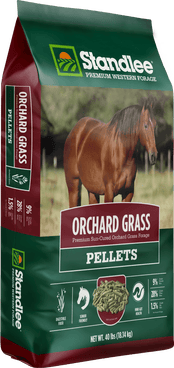FEEDING AND MANAGEMENT FOR AN OBESE HORSE
Dr. Tania Cubitt & Dr. Stephen Duren, Performance Horse Nutrition and Standlee Premium Products Nutritional Consultant

Don’t feed high-fat supplements. Vegetable oil, flaxseed and rice bran are high in fat and they are high in calories. Eliminate these supplements from your horse’s diet and you can cut out a large number of calories and prevent excessive weight gain. Limit access to pasture by using a grazing muzzle and replace legume hay with grass hay. Legume hay, such as alfalfa and clover, contain more calories per pound than grass hays. Instead of alfalfa, feed a high-fiber, good quality grass hay (Timothy or Orchard Grass) free of dust, mold and weeds. Commercially available “balancer supplements” are ideal for these horses as they provide the animal with its mineral and vitamin requirements without adding excess calories.
Standlee recommends consulting with a veterinarian or equine nutritionist when changing your horse’s diet.
Obesity - What is it?
An obese horse is one that has accumulated body fat to the point that it begins to have a negative effect on health.
What are the Symptoms?
Obesity has a number of potentially negative effects, including: increased stress on the heart and lungs, greater risk of laminitis or founder, increased risk of developmental orthopedic (bone and joint) problems in young, growing horses, more strain on feet, joints, and limbs, worsened symptoms of arthritis, less efficient cooling of body temperatures, fat build-up around key organs which interferes with normal function, reduced reproductive efficiency, greater lethargy and decreased performance.
What are the Causes?
The causes of obesity in horses are simple: too much energy (calories) consumed, too few calories expended due to lack of exercise and certain medical conditions. Management of the obese horse requires changes in the feeding program as well as the exercise program.
Diagnosis:
The best way to determine if your horse is obese is to body condition score them. The Body Condition Scoring System is a numeric score to establish if a horse is fat or thin. Body condition scores go from one through nine. One meaning very skinny and nine meaning obese. Ideally, you want your horse to be around a five. A horse that is a five has a flat back, its shoulders and neck fade into the body smoothly, and the horse’s ribs are not easily noticeable.
Recommended Standlee Premium Products
Feeding & Management:
Weight reduction will only occur if the horse’s energy expenditure is greater than its energy intake. Weight loss can only be accomplished by reducing the number of calories going in and increasing the number of calories expended. So a combination of diet and exercise is in order to shed extra weight from an obese horse. If turnout space is limited or unavailable, the horse should be exercised regularly, provided it is sound and healthy. This is one of the best options for weight loss, especially if the horse is usually sedentary. If possible, exercise the horse more often than it had been before dieting, to increase the rate of weight loss. If an exercise or dry lot paddock is available, where there is no pasture available for grazing, regular turnout will allow for increased activity and weight loss.





